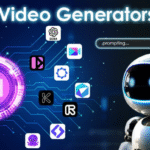In today’s fast-paced digital world, explainer videos have become essential for businesses aiming to capture attention, communicate effectively, and boost engagement. Traditionally, creating high-quality explainer videos has been time-intensive and costly, requiring significant skill in scripting, editing, and animation. However, with the rapid rise of artificial intelligence (AI), the process of explainer video creation is being completely redefined. AI-powered video apps are not only speeding up production but also making it accessible to people with minimal technical expertise. Let’s explore how AI is revolutionizing explainer video creation and reshaping digital marketing as we know it.
1. Automated Scriptwriting: Simplifying the Foundation
One of the most time-consuming steps in video production is writing a clear, engaging script. AI-driven video apps offer intelligent scriptwriting features, taking care of this initial step in a fraction of the time it traditionally requires. By analyzing keywords and specific prompts, AI algorithms can generate scripts that are tailored to the intended message and audience. These AI tools even adapt the tone to match brand requirements—whether it’s friendly, professional, or playful.
Example: For a company introducing a new product, AI can generate a persuasive, step-by-step script that highlights key features, benefits, and uses, reducing the need for extensive brainstorming and revisions.
2. AI-Generated Visual Content: A New Level of Accessibility
Another revolution brought by AI in the explainer video maker tools is the ability to automatically select or even generate visual elements, such as graphics, images, and short video clips. With access to massive libraries of media, AI-driven video apps use algorithms to match these elements with the script, creating a seamless flow of visual storytelling. This eliminates the need to source or create visuals manually, which can be both time-consuming and costly.
Example: If the script talks about “AI marketing trends,” the video app will pull relevant visuals of marketing graphs, animated icons, and trend indicators, ensuring that the imagery aligns with the messaging.
3. Automated Voiceovers and Text-to-Speech
Creating voiceovers for explainer videos can be expensive and challenging for those without access to a studio or professional voice talent. Thanks to AI’s text-to-speech capabilities, video apps can now generate realistic voiceovers that sound natural and engaging. Many AI-powered platforms offer a wide range of voice options, tones, and accents to match the brand’s voice, whether for a global audience or a specific demographic.
With AI voice synthesis, brands can produce videos that sound human and connect emotionally with audiences, without needing to invest in recording equipment or talent. This is particularly valuable for small businesses looking to elevate their marketing on a budget.
4. AI-Enhanced Editing: Perfecting Timing and Transitions
Professional editing is essential to make a video flow naturally, but mastering transitions, timing, and effects typically requires skill and experience. AI-driven tools have simplified this through features like automated timing, transitions, and even stylistic effects. AI assesses the pacing of the script and aligns it with visual transitions, animations, and even music choices to create a polished result.
Example: For an explainer video introducing a new mobile app, the AI might use transitions to smoothly move between key features, adding subtle animations to highlight each one, all while maintaining an engaging rhythm.
5. Personalization at Scale with AI Marketing Insights
Personalization is critical in today’s marketing landscape, and AI-powered video apps are making it possible to create highly targeted explainer videos that resonate with specific audience segments. Through AI marketing insights, brands can quickly adjust the tone, length, and messaging of their videos to appeal to different customer demographics or interests. With AI, it’s easy to produce multiple versions of a single video, tailored to different buyer personas or platforms (like YouTube, Instagram, or LinkedIn).
Example: An AI-driven explainer video for a fitness product might adjust its messaging to focus on health benefits for older audiences, while highlighting high-energy workouts and community building for younger viewers.
6. Subtitles and Accessibility Features
As inclusivity becomes a priority for brands, AI-driven tools are adding accessibility features like automatic subtitle generation and multi-language support. AI can generate accurate subtitles, making videos more accessible to viewers with hearing impairments or those who prefer watching without sound. Additionally, with multi-language support, brands can reach broader audiences without the need for separate translation and subtitle services.
Example: A global brand can create one explainer video and leverage AI to automatically generate translations, opening up new markets and enhancing customer experience.
7. Cost Efficiency: High-Quality Production on a Budget
Before AI-powered tools, creating a high-quality explainer video required significant investment in resources. With AI video apps, the barriers to entry are dramatically lowered, as many essential elements—script, visuals, voiceovers, and editing—are automated. This cost reduction makes explainer videos a viable option for smaller businesses that may not have a large marketing budget.
Example: A startup can now create a professional-grade explainer video with the same impact as larger companies, making it easier to compete and build brand visibility.
8. Instant Updates and Iterations
The ease of iterating and updating content is another major advantage of using AI-driven video apps. In traditional production, making changes to an existing video could be time-consuming and costly. With AI, updates can be made almost instantly, making it easier to keep explainer videos relevant and up-to-date.
Example: A tech company that frequently releases product updates can use AI to refresh their explainer videos without starting from scratch, ensuring that their marketing materials are always current.
Conclusion
AI is transforming explainer video creation by streamlining production, enhancing accessibility, and allowing for personalized content at scale. From automated scriptwriting to voiceover generation, video apps equipped with AI make creating explainer videos faster, easier, and more cost-effective. For businesses large and small, the adoption of AI in video creation is not just a trend but a powerful shift that offers a competitive edge. As AI technology continues to evolve, the possibilities for explainer videos will only expand, empowering brands to communicate their message more effectively than ever.
With AI-powered tools revolutionizing video creation, brands can now leverage explainer videos in their AI marketing strategies to engage audiences, foster brand loyalty, and boost conversions. Whether you’re a large enterprise or a small startup, embracing AI-driven video creation will keep your marketing fresh, effective, and impactful.
For More Information Visit Timelymagazine








